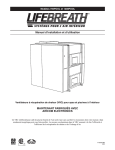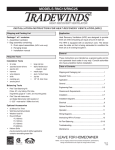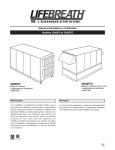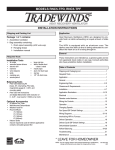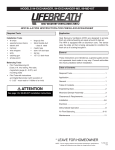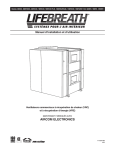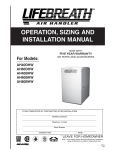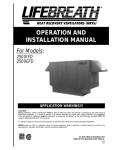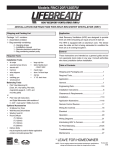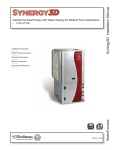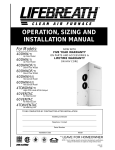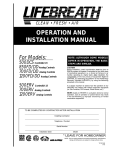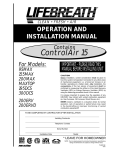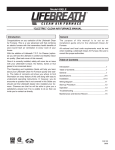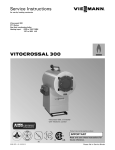Download Lifebreath CAF-02-MB User's Manual
Transcript
OPERATION, SIZING AND INSTALLATION MANUAL CLEAN AIR FURNACE NOW MANUFACTURED WITH AIRCOM ELECTRONICS NOTE: ALTHOUGH SOME MODELS DIFFER IN OPERATION, THE BASIC STEPS ARE SIMILAR. CAUTION It is always important to assess how the operation of any HRV/ERV may interact with vented combustion equipment (ie. Gas Furnaces, Oil Furnaces, Wood Stoves, etc.). NEVER install an HRV/ERV in a situation where its normal operation, lack of operation or partial failure may result in the backdrafting or improper functioning of vented combustion equipment!!! TO BE COMPLETED BY CONTRACTOR AFTER INSTALLATION Installing Contractor Telephone / Contact Serial Number Installation Date Model * LEAVE FOR HOMEOWNER NOTE: Due to ongoing research and product development, specifications, ratings and dimensions are subject to change without notice. CAF-02-MB 1203 Table of Contents Introduction ............................................................................................................ 3 Description and Purpose ........................................................................................ 4 Combo System Basic Principle ................................................................................ 5 Model Number Nomenclature Breakdown ...................................................................... 12 Specifications ................................................................................................. 13 - 21 Installation .................................................................................................... 22 - 27 Plumbing .............................................................................................................. 28 Function and Controls ..................................................................................................... 29 ECM Motor Settings ........................................................................................................ 30 Operation ......................................................................................................................... 31 Start Up Procedure.......................................................................................................... 32 Troubleshooting .............................................................................................. 33 - 34 System Commissioning .......................................................................................... 35 Work Sheets ................................................................................................. 36 - 41 Wiring Diagrams ....................................................................................................... 42 - 43 2 Introduction Congratulations on your selection of the LIFEBREATH Clean Air Furnace (CAF). This is a very advanced unit that combines the outstanding efficiency and economy of the water heater/airhandler concept, plus the tremendous health benefits of year-round fresh air ventilation in every room of your house. With the addition of LIFEBREATH Turbulent Flow Precipitator (TFP) Air Cleaner (optional) you will have the ultimate in comfort and healthy indoor air quality. You will notice that the heated air in your home feels more comfortable than air heated by a conventional furnace. One reason for this is that LIFEBREATH's hydronically heated air is uniform and temperate... no short blasts of hot air or hot and cold temperature spikes. In this regard, the air flowing from your hot air vents will not feel as hot to the touch as air from a conventional furnace. With a high efficiency, adequately sized hot water heater/boiler, you will always have plenty of hot water for showers and baths, washing dishes and clothes, and all other normal domestic hot water needs. If there is an unusually high demand for hot water, such as filling a large hot tub, than all you need to do is allow more time for the task so the water heater/boiler can keep up to its job of providing hot water for the heating system as well as other household uses. Once it is correctly installed, safety will never be an issue with your LIFEBREATH furnace. No flames, fumes or flue gases to be concerned about. Your domestic hot water heater/boiler now provides the heat source for your furnace. This Operating and Installation Guide will help you learn about your LIFEBREATH Clean Air Furnace quickly and easily. The table of contents will show you where to find information on every feature of this unit along with easy to understand operating instructions. If, however, you do encounter a question that is not covered in this Guide you should call the LIFEBREATH dealer who installed your furnace. Chances are that he will be able to give you a satisfactory answer but if he is unable to do so then we invite you to contact us directly. Nutech Brands Inc. HRV - Aluminum Core A Heat Recovery Ventilator (HRV) is designed to provide fresh air into a building while exhausting an equal amount of stale air. During the winter months, the incoming cold fresh air is warmed by utilizing the heat recovered from the stale air before it is exhausted to the outdoors. During summer months when the indoor space is air conditioned, the Heat Recovery Ventilator will help in cooling the incoming fresh air with the stale air that is being exhausted. ERV - Enthalpic Paper Core An Energy Recovery Ventilator (ERV) is designed to provide fresh air into a building while exhausting an equal amount of stale air. An ERV is designed for use in warm humid areas with heavy air conditioning use. The ERV will transfer both sensible and latent heat from the incoming fresh air to the outgoing stale air thereby reducing the load (due to ventilation) on the air conditioning system. ERVs are not suitable for climates where the temperature drops below -4˚C (25˚F). 3 Description and Purpose IMPORTANT NOTE Combining two or more end uses such as space heating and the heating of domestic hot water in a single system has the potential to increase efficiency and reduce overall capital costs. However, the proper design, installation, and commissioning of these systems are critical if these advantages are to be realized. The purpose of this manual is to act as an installation guide only for the LIFEBREATH Clean Air Furnace. Manufacturers' instructions for other components, such as the waterheater/boiler, must be followed. All national and local code requirements must be met when installing a LIFEBREATH Clean Air Furnace. Be sure to consult the proper authorities. This manual provides a guideline of good engineering practice in the design, installation and commissioning of Integrated Combo Systems. The guidelines in the manual are designed for residential forced warm air Integrated Combo Systems which utilize domestic water heaters or boilers and the LIFEBREATH furnace. Heating and cooling loads shall be calculated in accordance with recognized Residential Heat Loss and Heat Gain Calculation methods. Duct design shall comply with recognized Residential Air System Design methods. This manual provides worksheets to be used for the purpose of sizing residential water heaters and the combo furnace. Note: Temperatures greater than 130 °F (54°C) pose a serious risk of scalding individuals running domestic hot water for potable use. This appliance complies with IAS Canada Inc. Requirement CR95-003, Additional Requirements for Fan Coil Units for use with Potable Water Heaters. All piping and components connected to this appliance shall be suitable for use with potable water. Toxic chemicals, such as used for boiler treatment, shall not be introduced into the potable water heater system. The LIFEBREATH Clean Air Furnace is a volume ventilator system and is not intended to replace a fully ducted Heat Recovery Ventilation (HRV) system. Independent exhaust fans should be used for bathrooms and kitchen range hoods. When using this system, and water for space heating is required to be at a higher temperature than for other uses, an anti-scald valve shall be used to ensure water for other uses is reduced in temperature to minimize a scald hazard potential. 4 Combo System Basic Principles Closed/Open Combo System Therefore, an expansion tank (or equivalent device) may be installed as part of any closed system. The operations of the valve and expansion tank are discussed later in this section of this manual. From the aspect of delivery of domestic hot water and space heating, the Open and Closed systems operate the same. A system becomes closed when a backflow prevention valve or check valve is installed in the cold water piping upstream of the water heater. A backflow prevention valve will prevent the pressure created when water is heated in the water heater, from being relieved into the cold water system. Note: Water systems that incorporate a pressure tank (well systems) are normally open systems. DOMESTIC HOT WATER COLD WATER INLET CHECK VALVE VALVE (shut off) SUPPLY AIR ANTI-SCALD VALVE COOLING COIL SCHEMATIC SYSTEM DIAGRAM (Closed Loop System) (OPTIONAL) (WHEN REQUIRED) EXPANSION TANK OR OTHER MEANS VALVE (shut off) (WHEN REQUIRED) RETURN AIR VALVE VALVE (shut off) (balancing) CHECK VALVE WATER HEATER HEATING COIL HRV/ERV CORE DRAIN VALVE BLOWER DOMESTIC HOT WATER COLD WATER INLET SCHEMATIC SYSTEM DIAGRAM (Open System) VALVE (shut off) SUPPLY AIR ANTI-SCALD VALVE COOLING COIL (OPTIONAL) (WHEN REQUIRED) VALVE (shut off) RETURN AIR VALVE VALVE (shut off) (balancing) CHECK VALVE WATER HEATER Note: Plumbing components and system configuration may vary from diagram portrayed. Refer to local codes, local bylaws and installation manuals supplied with water heater before starting any installation work. HEATING COIL HRV/ERV CORE DRAIN VALVE BLOWER 5 Call for Space Heating Only Operation Air System A circulation fan draws cool house air at approx. 70˚F (21˚C) from the return ductwork, forces it through the water coil where it is heated, and then distributes it to the various rooms of the house through the supply ductwork. When the thermostat calls for heat, the circulation pump is activated and hot water is drawn from the top of the water heater through the air handler, and then returned to the water heater. There should be at least a 20˚F (11˚C) temperature drop between the hot water supplied to the air handler and the returning water temperature. If the temperature drop is less then 20˚F (11˚C) two things may happen: Water Piping The Piping and fittings used to connect the water heater and air handler must be sized to handle the volume of hot water required by the air handler within the pressure limitations of the circulation pump. All piping, fittings solders, and fluxes must be acceptable for use with domestic hot water. 1. Mixing of warm return water with the hot water within the water heater (no tank stratification), which will result in a lower hot water supply temperature. 2. A water heater thermostat temperature differential (between on and off) is approximately 18˚F (10˚C). Therefore, if the return water is not cool enough, it may not activate the water heater thermostat, which causes the burner to operate. All of the water in the water heater will be cooled before the burner begins to operate. This may cause large swings in the delivered hot water temperature, causing poor space heating performance, fluctuating domestic water temperatures and effectively reducing the supply of domestic hot water. Note: Chemicals (such as boiler system additives) cannot be added to the system because water passing through the heating loop re-enters the domestic water systems. Circulation Pump The circulation pump is factory installed within the air handler. The water flow rate will vary depending on the pumps performance and the head pressure (resistance) of the complete heating loop system. Call for Domestic Hot Water and Space Heating Operation When both return water from the space heating loop and new cold water (replacing domestic water being used) enters the water heater, the mixed entering water is cool enough to activate the thermostat quickly. In this situation, the water heater must be capable of satisfying the combined need for hot water (domestic hot water and space heating) at the same time. 6 Manual Valves There are a number of manual valves required for the system to operate properly and safely. These valves are used as shut off valves, drain valves and throttling valves. They can be globe, gate, ball or balancing type valves. malfunction with age. Gate valves tend to be less expensive than the other type of valves. The globe valve can be used as a shut off, drain or throttling valve. Even in the open position, the valve is fairly restrictive to flow. It has a much greater equivalent length (resistance) than the other types of valves. The ball valve can be used as a shut off or drain valve but not a throttling (balancing) valve. When in the open position, a full bore ball valve has very little resistance to flow, and these valves tend to be both the least expensive and the least susceptible to seizing over time. Do not use reduced bore ball valves as they are very restrictive to water flow. The gate valve can be used as a shut off or drain valve. When in the open position, there is very little resistance to flow. Gate valves have a greater susceptibility to chatter (noise) and The balancing valve can be used as a throttling valve. It can make small flow changes easily and has lower resistance than a globe valve. This valve will be considerable more expensive. Balance Valve Globe Valve Ball Valve Gate Valve 7 Shut Off Valves There are 3 shut off valves required for an integrated combo system as follows: • system. The drain valve should be near the low point of the return piping system upstream of the shut off valve and is preferred to be near the water heater. One valve (a) on the cold water side of the water heater upstream of the heating loop connection. This valve has the ability to isolate the hot water (domestic and space heating) from the household cold water supply. This valve is required on every water heater whether or not the water heater is used for space heating. • One valve (b) on the hot water supply side of the heating loop, downstream of its connection to the domestic water. • One valve (c) on the return side of the heating loop upstream of its connection to the domestic cold water. Throttling Valve The throttling (balancing) valve is used to reduce the water flow rate and thereby increase the water temperature drop. This is done to ensure proper activation of the water heater thermostat. This valve should be a globe or balancing valve. Check Valves A spring loaded check valve is required in the heating loop to help minimize thermo-siphoning of hot water throughout the heating loop when heating is not called for and cold water back flowing through the heating loop when domestic hot water is used. The valve will have a water flow direction arrow marked on it’s exterior surface and must be installed with that arrow pointing downstream. The two valves in the heating loop allow the heating loop to be isolated for service or repair. (a) Supply (b) (c) Return C H SHUT OFF VALVES CHECK VALVE Drain Valve A drain valve is required to allow the heating loop to be drained for service or repair and to remove air from the heating loop when commissioning a * Check valves should always be installed in a vertical rise with the flow of water shown. 8 Expansion Tanks Note: There are a number of pressure balancing valves and mixing valves on the market which are not certified as a anti-scalding device. Expansion tanks are required for “Closed Systems”(most municipal water systems are closed systems). The expansion tank has an air bladder, which will contract to relieve pressure in the system. Pressure is created in the closed system when water is heated in the water heater. Expansion tanks should always be connected to the cold water piping between the water heater shut off valve and the cold water inlet to the water heater. Follow manufacturers instructions for sizing and installation. cold Time to Scald (1st degree burns) hot water Temperature Time 120˚F 8 min. 130˚F 20 sec. 140˚F 3 sec. 160˚F <1 sec. Off Season Circulation Timer air cushion Although the UCG (Unified Canadian Guideline) does not require these controls, a few building codes and municipal by-laws do. They are used to provide periodic circulation of water through the space heating loop during the summer and other periods of infrequent use. The concern is that water which remains stationary in the heating loop during the summer may be less than desirable as domestic hot water when it is returned to the water heater at system startup in the fall. EXPANSION TANKS Anti-Scald Valve An anti-scald valve is required when the water heater thermostat is set above 140˚F (60˚C). Also, an anti-scald valve may be required for all installations by the “authority having jurisdiction”. The valve is placed in the hot water supply piping from the water heater downstream of the heating loop connection and upstream of any domestic hot water connection. Thermostats There are two thermostats controlling every combo system, the water heater thermostat controlling the hot water temperature and the room thermostat controlling the room air temperature. The purpose of the valve is to limit the maximum temperature available for domestic hot water by mixing hot water from the water heater with cold water from the municipal supply. The Anti-Scald valve must be thermostatically controlled and approved to the ASSE standard No. 1016 and 1017 for use as an anti-scald device. 9 Water Heater Thermostat The hot water inlet temperature is typically 140˚F (60˚C). If this temperature must be increased to achieve higher outputs from the furnace an anti-scald valve must be used to prevent domestic hot water temperatures above 140˚F (60˚C). The manufacturer of the Hot Water Tank should be consulted for temperatures higher than 140˚F. The water heater ther mostat is set by the installing contractor to provide the required temperature at the hot water outlet of the water heater. It is important that a warning label be placed near the water heater thermostat telling the homeowner not to change the thermostat setting. The label is included with the furnace. Hot Water Flow Rate Room Thermostat The room thermostat controls both the water circulation pump and the air circulation fan. It should be on a centrally located, inside wall away from any source of heat such as diffusers, appliances and direct sunlight. The hot water entering the water coil is the source of heat to the air handler. The effect of changing the amount of water entering the coil is the same as changing the water temperature. As water flow is reduced, the output of the air handler and the air temperature rise will both be lowered. Energy Saving Room Thermostat Air Handler Return Air Temperature A set back thermostat or “smart stat” can be used with a combo system, but care must be taken in the timing of the temperature changes. The timing of morning warm up should be early enough that the desired air temperature has been reached before the people begin to use domestic hot water. The highest demand for space heating is during the morning warm up and the highest demand for domestic hot water is during morning showers. Even if the water heater is properly sized, it may not be able to meet this combined load. Therefore, large set backs should be avoided. The return air temperature entering the air handler is approx. 60˚F (33˚C) below the hot water inlet temperature. If the return air temperature entering the air handler is reduced, more heat transfer will occur and the output of the air handler will increase. Air Handler Air Flow Rate The air entering the air handler can only be warmed by the temperature difference between the hot water and the cool air. As the volume (CFM (L/s)) of air is reduced, the amount of heat which can be transferred is also reduced. Air Handler Output Capacity Air Handler Temperature Rise There are four factors that will significantly affect the heating output of the air handler. In a fuel fired furnace, the combustion gases can be 1000˚F (538˚C) above the return air temperature. These units typically have a temperature rise from 50˚F (10˚C) to 90˚F (32˚C) and therefore delivers air at the diffuser at 120˚F (49˚C) to 160˚F (71˚C). With an Integrated Combo System, the hot water They are: • • • • Hot water supply temperature (EWT) Hot water flow rate (GPM) Air Handler return air temperature Air Handler air flow rate (CFM) 10 temperature is approx. 130˚F (54˚C) which is 60˚F (15.5˚C) above the return air temperature. These units typically have a temperature rise of 35˚F (2˚C) to 40˚F (4˚C) and therefore would deliver air at the diffuser at approximately 105˚F (40.5˚C) to 110˚F (43˚C). Note: The vertical height of the heating loop does not impact on the head pressure as the pressure required to push the water up the vertical height is offset by the weight of the water in the vertical drop on the other side of the heating loop. Flow Rate Design vs. Field Conditions Flow rate is the amount of water flowing in the system. It is directly related to the head pressure and the resistance to flow. Flow rate is measured in gallons per minute (liters per minute). The factors discussed above become very important to consumer comfort. Even small differences between design parameters and actual field conditions can impact greatly on output capacity. Therefore, it is important to do a thorough and complete commissioning of the integrated combo system to ensure the design parameters are met. Pressure Drop (PD) Pressure drop (PD) is the reduction in total pressure caused by components added to a piping system such as coils, valves, and fittings. The measurement of pressure drop is the difference in pressure on the inlet side of the component and the outlet side. Pressure drop is measured in feet of water (millimeters of water). Water System Pressures Within the water system of an Integrated Combo system, there are three ter ms that the designer/installer must understand. These are head pressure, water flow rate, and pressure drop. When connecting the water lines for heating loop (air handler) to the domestic water system, the pipes should be connected with a “tee” to the side of a vertical domestic water pipe or the bottom of a horizontal domestic water pipe. This is to help prevent air from entering the heating loop. The connections should be as near as practical to the water heater. Head Pressure Head pressure is the pressure created by the circulation pump to push water through the piping system. It is this pressure which is used to overcome the resistance to water flow (friction) caused by the water pipe and fittings. It is similar in concept to the exter nal static pressure in an air duct system. Head pressure is measured in feet of water (millimeters of water). Note: Although the water in the combo system is pressurized by the domestic water system the pump is required to create water flow in the heating loop. The domestic water system applies the same pressure to the supply and return sides of heating loop. 11 Model Number Nomenclature Breakdown Example Model Number CAF - U - S2A - 24 - P16 Model Configuration CAF - Clean Air Furnace (Built-in HRV) AH - Air Handler (No HRV) Configuration U - Upflow D - Downflow H - Horizontal Hydronic Coil Size S2A - Small Coil - 2 Row (output chart A) S4A - Small Coil - 4 Row (output chart A) L2A - Large Coil - 2 Row (output chart A) L4A - Large Coil - 4 Row (output chart A) L2B - Large Coil - 2 Row (output chart B) 00 - No Hydronics (No Heating Coil, No Pump) * CFM (High Speed) Cooling Capacity 24 - 2 tons 30 - 2.5 tons 36 - 3.0 tons 48 - 4.0 tons *Cooling coils not available from Nutech Note: Motor Configuration Refer to individual specification pages for Hydronic Coil and Blower configurations. This sheet is for pre-configured Model Number Breakdown only. P16 - Standard PSC Motor 120V/60Hz E15 - Upgrade ECM Motor 120V/50Hz E16 - Upgrade ECM Motor 120V/60Hz E25 - Upgrade ECM Motor 220V/50Hz E26 - Upgrade ECM Motor 220V/60Hz 12 Specifications Core Filters Case Model CAF-U-S4A-24-P16 Ventilation system has patented aluminum heat recovery core (standard) or an enthalpic energy recovery core (optional) for energy-efficient ventilation. Enthalpic cores are recommended for regions where the temperature does not drop below 25˚F (-4˚C). Washable air filters in exhaust and supply air streams of ventilation section, 1" pleated in return plenum side. Prepainted galvanized steel for superior corrosion resistance. Dimensions & Clearances Front Side 12" 16" Top Latches 4" 19" 17.25" 6" Ventilation Supply Air Inlet 6" Ventilation Exhaust Air Outlet Supply Air 29.5" 47.5" 22" 14" Blower Section Return Air Note: Ventilation ports and return plenum opening available off either side of cabinet. All units conform to CSA and UL Standards. (SERVICE CLEARANCE 3') Voltage 120 VAC 60 Hz Hp 1/3 Amps (total) 7 Water Connections 1/2" Copper Soldered Connection Airflow (High) .25 in wg .5 in. wg 1030 CFM 890 CFM Ventilation Airflow 100 - 140 CFM Effectiveness (Aluminum Core) 70% Total Efficiency (Enthalpic Core) 50% Net Weight 150 lbs. Shipping Weight 165 lbs. Warranty Options 99-186 CAF-U-S4A-24-P16 19" 29.5" (SERVICE CLEARANCE 1') Model Weatherhoods, Two - 6" c/w 1/4" mesh screen 99-130W Remote Wall Mount Dehumidistat Control 24 VAC only 99-RSK6 6” back draft damper 99-104 DET - Digital Electronic Timer Units carry a lifetime warranty on the heat recovery (aluminum) core, a five year warranty on the energy recovery (enthalpic) core and a five year replacement parts warranty on all other components. 0212 13 Specifications Model CAF-U-L4A-36-P16 Core Ventilation system has patented aluminum heat recovery core (standard) or an enthalpic energy recovery core (optional) for energy-efficient ventilation. Enthalpic cores are recommended for regions where the temperature does not drop below 25˚F (-4˚C). Filters Washable air filters in exhaust and supply air streams of ventilation section, 1" pleated in return plenum side. Case Prepainted galvanized steel for superior corrosion resistance. Dimensions & Clearances Side Front 12" 22.25" Top Latches 4" 19" 17.25" 6" Ventilation Supply Air Inlet 6" Ventilation Exhaust Air Outlet Supply Air 29.5" 47.5" 22" 14" Blower Section Return Air Note: Ventilation ports and return plenum opening available off either side of cabinet. 19" 29.5" All units conform to CSA and UL Standards. (SERVICE CLEARANCE 1') (SERVICE CLEARANCE 3') CAF-U-L4A-36-P16 Voltage 120 VAC 60 Hz Hp 1/2 Amps (total) 8.7 Water Connections 3/4" Copper Soldered Connection Airflow (High) .25 in wg .5 in. wg 1350 CFM 1180 CFM Ventilation Airflow 100 - 140 CFM Effectiveness (Aluminum Core) 70% Total Efficiency (Enthalpic Core) 50% Net Weight 150 lbs. Shipping Weight 165 lbs. Warranty Options 99-186 Model Weatherhoods, Two - 6" c/w 1/4" mesh screen 99-130W Remote Wall Mount Dehumidistat Control 24 VAC only 99-RSK6 6” back draft damper 99-104 DET - Digital Electronic Timer Units carry a lifetime warranty on the heat recovery (aluminum) core, a five year warranty on the energy recovery (enthalpic) core and a five year replacement parts warranty on all other components. 0212 14 Specifications Model CAF-D-S4A-24-P16 Core Ventilation system has patented aluminum heat recovery core (standard) or an enthalpic energy recovery core (optional) for energy-efficient ventilation. Enthalpic cores are recommended for regions where the temperature does not drop below 25˚F (-4˚C). Filters Washable air filters in exhaust and supply air streams of ventilation section, 1" pleated in return plenum side. Case Prepainted galvanized steel for superior corrosion resistance. Dimensions & Clearances Model Top 19" 29.5" CAF-D-S4A-24-P16 Voltage 120 VAC 60 Hz Hp 1/3 22" 19" 14" Return Air Return Air Blower Section 14" 22" 29.5" 16" Bottom Ventilation Exhaust Air Outlet 47.5" Ventilation Supply Air Inlet 19" 17.25" 6" 6" 4" Latches Supply Air 12" 29.5" Front Side (SERVICE CLEARANCE 3') Amps (total) 7 Water Connections 1/2" Copper Soldered Connection Airflow (High) .25 in wg .5 in. wg 1030 CFM 890 CFM Ventilation Airflow 100 - 140 CFM Effectiveness (Aluminum Core) 70% Total Efficiency (Enthalpic Core) 50% Net Weight 150 lbs. Shipping Weight 165 lbs. (SERVICE CLEARANCE 1') Note: Ventilation ports and return plenum opening available off either side of cabinet. All units conform to CSA and UL Standards. Warranty Options 99-186 Weatherhoods, Two - 6" c/w 1/4" mesh screen 99-130W Remote Wall Mount Dehumidistat Control 24 VAC only 99-RSK6 6” back draft damper 99-104 DET - Digital Electronic Timer Units carry a lifetime warranty on the heat recovery (aluminum) core, a five year warranty on the energy recovery (enthalpic) core and a five year replacement parts warranty on all other components. 0212 15 Specifications Model CAF-D-L4A-36-P16 Core Ventilation system has patented aluminum heat recovery core (standard) or an enthalpic energy recovery core (optional) for energy-efficient ventilation. Enthalpic cores are recommended for regions where the temperature does not drop below 25˚F (-4˚C). Filters Washable air filters in exhaust and supply air streams of ventilation section, 1" pleated in return plenum side. Case Prepainted galvanized steel for superior corrosion resistance. Dimensions & Clearances Top 19" 29.5" 22" 19" 14" Return Air Return Air Blower Section 14" 22" 29.5" 22.25" Bottom Ventilation Exhaust Air Outlet 47.5" Ventilation Supply Air Inlet 19" 17.25" 6" 6" 4" Latches Supply Air 12" 29.5" Front Side Model CAF-D-L4A-36-P16 Voltage 120 VAC 60 Hz Hp 1/2 Amps (total) 8.7 Water Connections 3/4" Copper Soldered Connection Airflow (High) .25 in wg .5 in. wg 1350 CFM 1180 CFM Ventilation Airflow 100 - 140 CFM Effectiveness (Aluminum Core) 70% Total Efficiency (Enthalpic Core) 50% Net Weight 150 lbs. Shipping Weight 165 lbs. (SERVICE CLEARANCE 3') (SERVICE CLEARANCE 1') Note: Ventilation ports and return plenum opening available off either side of cabinet. All units conform to CSA and UL Standards. Warranty Options 99-186 Weatherhoods, Two - 6" c/w 1/4" mesh screen 99-130W Remote Wall Mount Dehumidistat Control 24 VAC only 99-RSK6 6” back draft damper 99-104 DET - Digital Electronic Timer Units carry a lifetime warranty on the heat recovery (aluminum) core, a five year warranty on the energy recovery (enthalpic) core and a five year replacement parts warranty on all other components. 0212 16 Specifications Model CAF-H-S4A-24-P16 Core Ventilation system has patented aluminum heat recovery core (standard) or an enthalpic energy recovery core (optional) for energy-efficient ventilation. Enthalpic cores are recommended for regions where the temperature does not drop below 25˚F (-4˚C). Filters Washable air filters in exhaust and supply air streams of ventilation section, 1" pleated in return plenum side. Case Prepainted galvanized steel for superior corrosion resistance. Service drain 1/2” or 3/4” NPT. Dimensions & Clearances 16" 14" Top Return Air 29.5" 19" 22" Ventilation Exhaust Air Outlet 6" 17.25" 6" 12" 4" Supply Air End Latches 14" Return Air Return 19" Air End CAF-H-S4A-24-P16 Voltage 120 VAC 60 Hz Hp 1/3 Amps (total) 7 Water Connections 1/2" Copper Soldered Connection Airflow (High) .25 in wg .5 in. wg 1030 CFM 890 CFM 29.5" 22" 19" Supply Air Ventilation Supply Air Inlet Model Blower Section Front 47.5" 29.5" (SERVICE CLEARANCE 10") Service Drain Ventilation Airflow 100 - 140 CFM Effectiveness (Aluminum Core) 70% Total Efficiency (Enthalpic Core) 50% Net Weight 150 lbs. Shipping Weight 165 lbs. Note: All units conform to CSA and UL Standards. Warranty Options 99-186 Weatherhoods, Two - 6" c/w 1/4" mesh screen 99-130W Remote Wall Mount Dehumidistat Control 24 VAC only 99-RSK6 6” back draft damper 99-104 DET - Digital Electronic Timer Units carry a lifetime warranty on the heat recovery (aluminum) core, a five year warranty on the energy recovery (enthalpic) core and a five year replacement parts warranty on all other components. 0302 17 Specifications Model CAF-H-L4A-36-P16 Core Ventilation system has patented aluminum heat recovery core (standard) or an enthalpic energy recovery core (optional) for energy-efficient ventilation. Enthalpic cores are recommended for regions where the temperature does not drop below 25˚F (-4˚C). Filters Washable air filters in exhaust and supply air streams of ventilation section, 1" pleated in return plenum side. Case Prepainted galvanized steel for superior corrosion resistance. Service drain 1/2” or 3/4” NPT. Dimensions & Clearances 22" Side 14" Return Air 29.5" 19" 22" Ventilation Exhaust Air Outlet 6" Supply Air 17.25" Ventilation Supply Air Inlet 6" 12" 4" 29.5" Supply Air End Front Latches 22" 19" 14" Return Air Return 19" Air End Blower Section 47.5" 29.5" (SERVICE CLEARANCE 10") Model CAF-H-L4A-36-P16 Voltage 120 VAC 60 Hz Hp 1/2 Amps (total) 8.7 Water Connections 3/4" Copper Soldered Connection Airflow (High) .25 in wg .5 in. wg 1350 CFM 1180 CFM Ventilation Airflow 100 - 140 CFM Effectiveness (Aluminum Core) 70% Total Efficiency (Enthalpic Core) 50% Net Weight 150 lbs. Shipping Weight 165 lbs. Service Drain Note: All units conform to CSA and UL Standards. Warranty Options 99-186 Weatherhoods, Two - 6" c/w 1/4" mesh screen 99-130W Remote Wall Mount Dehumidistat Control 24 VAC only 99-RSK6 6” back draft damper 99-104 DET - Digital Electronic Timer Units carry a lifetime warranty on the heat recovery (aluminum) core, a five year warranty on the energy recovery (enthalpic) core and a five year replacement parts warranty on all other components. 0302 18 Specifications Model CAF-U-L2A-48-P16 Core Ventilation system has patented aluminum heat recovery core (standard) or an enthalpic energy recovery core (optional) for energy-efficient ventilation. Enthalpic cores are recommended for regions where the temperature does not drop below 25˚F (-4˚C). Filters Washable air filters in exhaust and supply air streams of ventilation section, 1" pleated in return plenum side. Case Prepainted galvanized steel for superior corrosion resistance. Dimensions & Clearances Front Side Model CAF-U-L2A-48-P16 Voltage 120 VAC 60 Hz Hp 1/3 Amps (total) 8.7 Water Connections 1/2" Copper Soldered Connection Airflow (High) .25 in wg .5 in. wg 1888 CFM 1589 CFM 12" Latches 22.25" Top 4" 17.25" 19" 6" 6" Supply Air Ventilation Supply Air Inlet Ventilation Exhaust Air Outlet 47.5" 22" 29.5" Return Air 14" Blower Section Note: Ventilation ports and return plenum opening available off either side of 29.5" (SERVICE CLEARANCE 1') 19" Ventilation Airflow 100 - 140 CFM Effectiveness (Aluminum Core) 70% Total Efficiency (Enthalpic Core) 50% Net Weight 150 lbs. Shipping Weight 165 lbs. (SERVICE CLEARANCE 3') cabinet. All units conform to CSA and UL Standards. Warranty Options 99-186 Weatherhoods, Two - 6" c/w 1/4" mesh screen 99-130W Remote Wall Mount Dehumidistat Control 24 VAC only 99-RSK6 6” back draft damper 99-104 DET - Digital Electronic Timer Units carry a lifetime warranty on the heat recovery (aluminum) core, a five year warranty on the energy recovery (enthalpic) core and a five year replacement parts warranty on all other components. 0212 19 Specifications Model CAF-U-00-36-P16 Core Ventilation system has patented aluminum heat recovery core (standard) or an enthalpic energy recovery core (optional) for energy-efficient ventilation. Enthalpic cores are recommended for regions where the temperature does not drop below 25˚F (-4˚C). Filters Washable air filters in exhaust and supply air streams of ventilation section, 1" pleated in return plenum side. Case Prepainted galvanized steel for superior corrosion resistance. Dimensions & Clearances Side Front 12" 22.25" Top Latches 6" 4" 19" 17.25" Ventilation Supply Air Inlet Supply Air 6" 29.5" Ventilation Exhaust Air Outlet 47.5" 22" 14" Blower Section Return Air Note: Ventilation ports and return plenum opening available off either side of cabinet. All units conform to CSA and UL Standards. 19" 29.5" (SERVICE CLEARANCE 1') (SERVICE CLEARANCE 3') CAF-U-00-36-P16 Voltage 120 VAC 60 Hz Hp 1/2 Amps (total) 7.7 *Airflow (High) .25 in wg .5 in. wg 1350 CFM 1180 CFM Ventilation Airflow 100 - 140 CFM Effectiveness (Aluminum Core) 70% Total Efficiency (Enthalpic Core) 50% Net Weight 115 lbs. Shipping Weight 130 lbs. * Airflow performance assumes an evaporator coil static pressure loss of .25”WC Warranty Options 99-186 Model Weatherhoods, Two - 6" c/w 1/4" mesh screen 99-130W Remote Wall Mount Dehumidistat Control 24 VAC only 99-RSK6 6” back draft damper 99-104 DET - Digital Electronic Timer Units carry a lifetime warranty on the heat recovery (aluminum) core, a five year warranty on the energy recovery (enthalpic) core and a five year replacement parts warranty on all other components. 0211 20 Specifications Model CAF-U-00-48-P16 Core Ventilation system has patented aluminum heat recovery core (standard) or an enthalpic energy recovery core (optional) for energy-efficient ventilation. Enthalpic cores are recommended for regions where the temperature does not drop below 25˚F (-4˚C). Filters Washable air filters in exhaust and supply air streams of ventilation section, 1" pleated in return plenum side. Case Prepainted galvanized steel for superior corrosion resistance. Dimensions & Clearances Side Front 12" 22.25" Top Latches 6" 4" 19" 17.25" Ventilation Supply Air Inlet Supply Air 6" 29.5" Ventilation Exhaust Air Outlet 47.5" 22" 14" Blower Section Return Air Note: Ventilation ports and return plenum opening available off either side of cabinet. All units conform to CSA and UL Standards. 19" 29.5" (SERVICE CLEARANCE 1') (SERVICE CLEARANCE 3') Model CAF-U-00-48-P16 Voltage 120 VAC 60 Hz Hp 1/3 Amps (total) 7.7 *Airflow (High) .25 in wg .5 in. wg 1888 CFM 1589 CFM Ventilation Airflow 100 - 140 CFM Effectiveness (Aluminum Core) 70% Total Efficiency (Enthalpic Core) 50% Net Weight 132 lbs. Shipping Weight 147 lbs. * Airflow performance assumes an evaporator coil static pressure loss of .25”WC. Warranty Options 99-186 Weatherhoods, Two - 6" c/w 1/4" mesh screen 99-130W Remote Wall Mount Dehumidistat Control 24 VAC only 99-RSK6 6” back draft damper 99-104 DET - Digital Electronic Timer Units carry a lifetime warranty on the heat recovery (aluminum) core, a five year warranty on the energy recovery (enthalpic) core and a five year replacement parts warranty on all other components. 0209 21 Installation required for service of the filter, heat recovery core and components. As a rule this unit should be installed adjacent to the hot water heater. If this is not possible, or if the piping layout is complex, the total head pressure on the pump should be calculated. The purpose of this manual is to give the contractor guidelines for installing the LIFEBREATH Clean Air Furnace. All national and local codes relating to this type of equipment must be followed. Locating The Unit The Clean Air Furnace is designed to be installed vertically, (unless it is designated as a Horizontal unit ”H”), in a conditioned space, where the surrounding temperature does not fall below 50°F (10°C). Attic installations are not recommended. Typically the unit is installed in a mechanical area of the basement, or other partitioned mechanical room, elsewhere in the home. Duct Connections A location close to an outside wall is recommended, as the ventilation supply and exhaust portion will need to be ducted to the outside air. Sufficient clearance around the unit is Slide Heat Recovery Core out to remove ventilation knockouts. Never install ductwork directly to the cabinet that is smaller than the opening provided. To accommodate various installations, the Clean Air Furnace has knockouts for the return air plenum and ventilation ducts, on both sides of the cabinet. Special care and attention should be given to determining which knockouts are to be removed. Option 1 - Ventilation Ports Off Left Side Upflow Models Downflow Models Remove circular metal knockout Remove styrofoam knockout Remove styrofoam knockout Remove styrofoam knockout NOTE: Return plenum opening can be on either side of cabinet and is not dependent on which side the ventilation ports are on. 22 Option 2 - Ventilation Ports Off Right Side Downflow Models Upflow Models Remove circular metal knockout Remove styrofoam knockout Remove styrofoam knockout Remove styrofoam knockout Horizontal Models Remove circular metal knockout Penetrations from sheet metal screws used to fasten the ductwork to the cabinet of the unit should only be placed into the duct flange provided. This is to avoid contact and damage of the heating/air conditioning coils and internal wiring. Any ductwork running through unconditioned space must be sealed properly and insulated to prevent heat loss. All local codes must be followed in determining the amount of insulation needed. Ducting The ventilation section consists of two 6" (15.2cm) round ports located on the side of the cabinet, which vent to the outside. Insulated ducting with a vapour barrier such as flex-ducting, or ridged pipe wrapped in pipe sleeve, is required to prevent condensation from occurring on the pipe. Also the airflow in these lines is designed to be balanced. (See "Balancing Airflows" in this manual, for damper location and procedure). The duct sizing for the furnace section can be determined using HRAI Residential Air System Design Manual, SMACNA, or any other industryrecognized manuals. Note: "Combo units" normally deliver air at approx. 110°F (43°C), and therefore may require larger than normal ductwork. When installing the Clean Air Furnace as a replacement unit on a retrofit application, always calculate the size of duct that is there. Warning: A backdraft damper is required in the exhaust air duct to prevent cold air from entering the unit when the Clean Air Furnace is not running. 23 Locating Intake Weatherhood Outside Ducting the Weatherhoods The ventilation portion of the Clean Air Furnace can be vented off either side of the unit by removing knockouts provided. Once the knock outs in are removed, a bead of silicone can be placed on the plastic thermo-collars (provided), to form a seal between the collars and the cabinet. The collars can then be fastened into place with screws. Note the exhaust outlet is always the port on the bottom, and the supply inlet is always the port on the top, both ports should be labeled from the factory as such. The intake weatherhood should be located as follows: • 4 - 6' from ventilation exhaust hood, and upstream of prevailing winds, if possible. • At least 6' from a dryer vent, oil fill pipes, combustion outlets, gas meters, garbage containers or anything else, which may contaminate the air. • Do not locate fresh air intake in garages, crawl spaces or attics. • The ductwork from the outside weatherhoods to the unit, is usually flexible ducting, although rigid pipe may be needed if the runs are greater than 20 feet. In either case the pipes (both exhaust and supply and the added fittings) must be insulated, with a complete vapor barrier. To minimize restriction in airflows the ducting should be short, with as few bends as possible. See diagram below for recommended connection of insulated ducting to outside weatherhoods. Install 18" above grade, or above expected snow accumulation. Locating the Exhaust Weatherhoods The Exhaust Weatherhood should be located as follows: • At least 4-6' from the supply inlet • At least 18" above grade or expected snow accumulation • At least 3' from gas meters, combustion vents, or dryer vents • Do not install in garages, crawl spaces or attics Locating Weatherhood WEATHERHOOD INSTALLATION COLLAR IS SUPPLIED TO ENSURE VAPOUR BARRIER IS 100% SEALED TO WALL PLATE SCREEN (side view) 12" galvanized pipe supplied 1/4" (6 mm) SCREEN (front view) EXTERIOR WALL 1. Thermal Collar slides over galvanized sleeve of Weatherhood. 2. Fasten Thermal Collar to Belt. 3. Slide the Insulated Flexible Ducting over the Weatherhood's galvanized sleeve and fasten it to the Thermal Collar. 4. Hood is hinged to allow for easy access for cleaning of bird screen. 24 Pitot Tube Air Flow Balancing It is necessary to have balanced air flows in an HRV. The volume of air brought in from the outside must equal the volume of air exhausted by the unit. If the air flows are not properly balanced then: the ductwork. Procedure should be performed with the HRV on high speed. Choose the straightest section of duct between the HRV and the weatherhoods. This will be used for both the supply and return ducts. Drill a small hole in the duct (about 3/16"), three feet downstream of any elbows or bends, and one foot upstream of any elbows or bends. These are recommended distances but the actual installation may limit the amount of straight duct. • The HRV may not operate at its maximum efficiency • A negative or positive air pressure may occur in the house • The unit may not defrost properly • Failure to balance the HRV may void warranty 1. All sealing of the ductwork system has been completed. The Pitot tube should be connected to a magnehelic gauge or other manometer capable of reading from 0 to 0.25 in. (0 - 62 Pa) of water, preferably to 3 digits of resolution. The tube coming out of the top of the Pitot is connected to the high pressure side of the gauge. The tube coming out of the side of the Pitot is connected to the low pressure or reference side of the gauge. 2. All of the HRV's components are in place and functioning properly. Insert the Pitot tube into the duct, pointing the tip into the airflow. 3. Balancing dampers are fully open. For general balancing it is sufficient to move the Pitot tube around in the duct and take an average or typical reading. Repeat this procedure in the other (supply or return) duct. Determine which duct has the highest airflow (highest reading on the gauge). Then damper that airflow back to match the lower reading from the duct. The flows should now be balanced. Prior to balancing, ensure that: 4. Unit is on high speed. 5. After taking readings of both the stale air to the HRV duct and fresh air to the house duct, the duct with the lower CFM ([L/s] velocity) reading should be left alone, while the duct with the higher reading should be dampered back to match the lower reading. Actual airflow can be determined from the gauge reading. The value read on the gauge is called velocity pressure. The Pitot tube comes with a chart that will give the air flow velocity based on the velocity pressure indicated by the gauge. This velocity will be either feet per minute or metres per second. To determine the actual airflow, the velocity is multiplied by the cross sectional area of the duct being measured. 6. Return unit to appropriate fan speed for normal operation. Balancing Procedure The following is a method of field balancing an HRV using a Pitot tube, advantageous in situations when flow stations are not installed in 25 Placement of the Pitot Tube Pitot Tube and Gauge Pitot Tube Note: For best results keep Pitot tube well away from dampers. Figure B Figure A The accuracy of the airflow reading will be affected by how close to any elbows or bends the readings are taken. Accuracy can be increased by taking an average of multiple readings as outlined in the literature supplied with the Pitot tube. This is an example for determining the airflow in a 6" duct. The Pitot tube reading was 0.025 inches of water. From the chart, this is 640 feet per minute. The 6" duct has a cross sectional area of: = [3.14 x (6"÷12)2]÷4 = 0.2 square feet Balancing Collar Instructions The airflow is then: 640 ft./min. x 0.2 square feet = 128 cfm Push and turn with slotted screwdriver. Damper automatically locks when pressure is released. For your convenience, the cross sectional area of some common round duct is listed below: DUCT DIAM. (inches) CROSS SECTION AREA (sq. ft.) 5.0 6.0 7.0 BUILT-IN BALANCING DAMPERS .14 .20 .27 Insulated flexible ducting INSULATED PIPE WITH VAPOUR BARRIER OUTSIDE HOOD When connecting ductwork to the collar, take note where screws are located. Screws should be located no further than 1/2” from outside edge of collar, so as not to impede operation of the damper. BACK DRAFT DAMPER 1/2” Figure D Figure C 26 Drain Line The ventilation portion of the Clean Air Furnace has two drain pans for removing condensation, which may occur on the heat recovery core during cold weather. Stickers indicating direction of flow, (Supply to furnace, and Return to water heater) are labeled on the outside of the cabinet. Do not reverse these lines, as this will cause the unit to malfunction. Piping For piping conventional water heaters, connections to and from the Clean Air Furnace to the water tank should be made at the point where the pipes leave the tank vertically. A "T" fitting used in each vertical line, with the Clean Air Furnace piping connected to the horizontal side of this fitting, will work best in avoiding air locks in the circulation pump of the furnace. The hot water piping between the hot water tank and the Clean Air Furnace should be new copper type, and should not be treated with chemicals, sealant or anything else, that will interfere with the purity of the potable water. Only non-lead, low temperature solder is permitted for sealing copper joints. Where possible the length of pipe should not exceed 200' total equivalent length. Any piping running through unconditioned space must be insulated to prevent heat loss, and possible freezing of the line. *Note: Remove shipping block from underneath pump and discard. HRV Drain Line Diagram DRAIN SPOUT KNOCKOUT 2" DRAIN SPOUT KNOCKOUT TAPE TEE CONNECTOR THROUGH KNOCKOUT TO DRAIN 27 Plumbing This will allow for ease of service to remove any installation debris or service required due to extended hard water conditions. In order to improve serviceability of our products, the check valve is included with our manual kit for field installation between the air-handler and hot water source. Note: Take care during soldering to avoid debris or solder from lodging in the check valve. The check valve should be installed in a vertical run of pipe with the flow of water in an upward direction. Note: It is critical to follow the piping configuration shown. Maintain a minimum distance of 12” above the CAF/AH. This will minimize thermal siphoning in the combo system. An arrow on the check valve indicates its correct orientation and must match the direction of water flow. Figure 1 To House 12" Min. 12" above top of CAF / AH Check Valve CAF or AH Water Heater Figure 2 To House 12" Water Heater Check Valve Min. 12" above top of CAF / AH CAF or AH * It should be noted that problems have been observed when using the side tappings on certain water heaters; therefore, it is strongly recommended to use the top water tappings as indicated in Figure 1 to minimize thermal siphoning and related issues. For further information, please contact Technical Support (519) 457-1904. 28 Function & Controls Automatic Self Test Selecting Different Heat & Cool Speeds Approximate duration - 1.5 minutes. To select medium speed for heating or cooling, switch the appropriate DIP switch to the ON position. Unit will perform a self test each time power is first applied. Unit will cycle blower through all speeds, holding each for 15 seconds. Remainder of test is for circuit board tests, after which normal operation will resume. Example: To select medium speed for heating, switch the HEAT DIP switch to ON. To select medium speed for cooling, switch the COOL DIP switch to ON. (To select medium for both heat and cool, switch both heat and cool DIP switches to ON.) Basic Functions • Thermostat fan switch will control low speed fan operation • Call for heating - high speed • Call for cooling - high speed Connect two wires from dehumidistat to terminals T-23 and T-24 (low voltage 1820 gauge wire) Micro Processor Board T2 F1 MAX 1 amp T3 T4 T5 Line T6 Dehumidistat T21 T22 T23 T24 Pressure Sensor T7 FD POOL DD heat cool DFR2 SW1 T8 off on G T9 O Neutral GRN DET RED T10 T11 T12 T13 T14 T15 T16 YEL tat Dehumidis e to Relativ Setting Conditions Outside TER: WIN umidistat . Set deh 30% to 40% between is too dry, If home ing. higher sett adjust to too humid, is If home er setting. low adjust to : SUMMER at umidist Set deh to OFF. K6 Freeze R N.O. 24Vac T28 T29 T30 (Boosts unit to high speed when humidity is higher than setpoint) COM LD1 P3 Optional Remote Dehumidistat Part #99-130W F2 MAX 1 amp P2 Defrost Call technical support (519 457-1904) for more information. Y Cooling anticipators need to be disabled if used. W R Mechanical thermostats are not recommended. Spade Connections Thermostat C “Power stealing” thermostats are not compatible. C T26 T27 Note: T1 T25 (Thermostats are not available through Nutech) 12Vac Com Standard 24 Volt Thermostat Connection COM T19 T20 RELAY FEED T43 SPARE Vent Damper N.O. T18 K5 T17 N.O. COM Fan Low K4 Defrost Damper Fan Med N.O. COM Contact 2 N.0. COM N.C. N.0. COM N.C. N.0 . COM N.C. 29 Fan Hi K3 Contact 1 Boosts unit to high speed for 20,40 or 60 minutes T31 T32 T33 T34 T35 T36 T37 T38 T39 T40 T41 T42 Connect up to 4 maximum N.0. COM N.C. Optional Digital Electronic Timer (DET) Part #99-104 Location of Electrical Box in Furnace ECM MOTOR SETTINGS Switch Setting Fan Speeds Cool Switches Cool Both OFF High 1 0N - 2 OFF Med High 1 OFF - 2 ON Med Low 1 ON - 2 ON Low Switch Setting Fan Speeds Heat Switches Heat Both OFF High 3 0N - 4 OFF Med High 3 OFF - 4 ON Med Low 3 ON - 4 ON Low Switch Setting Fan Speeds Adjust Switches Heat Cool Both OFF Normal Normal 5 0N - 6 OFF Increase 15% Increase 15% 5 OFF - 6 ON Decrease 15% Decrease 15% 5 ON - 6 ON Normal Normal Delay Switches are for future use - no function at this time Note: Refer to individual specification pages for Airflow Performance specifications. Above settings correspond to DIP switch settings on the ECM circuit board only. Do not adjust DIP switches on MAIN Circuit Board. 30 Operation Heating/Cooling Ventilation When the room thermostat calls for heat, it activates a circulation pump located inside the Clean Air Furnace. This pump delivers hot water from the water heater, through the furnace coil and back to the water tank. Simultaneously, the furnace blower switches on to high speed and will start circulating air across the coil, which picks up heat and delivers it to the rest of your home. The heat recovery ventilation (HRV) portion of the Clean Air Furnace, is automatic. Once set, a desired amount of fresh air will be drawn into the home while the furnace blower is activated. To reduce humidity increased ventilation may be required during heating season. An optional remote dehumidistat can be installed. The dehumidistat will increase the speed of the furnace blower to high and will return to its original setting when humidity levels decrease. Your dehumidistat must be switched off during warmer months as it is not required for air conditioning operation. To increase humidity a quality humidifier should be added to the system. Once the thermostat's temperature is reached the pump will shut off, and the blower will return to its pre-set speed or off. Note: When the furnace blower is left running on low speed the air in the home circulates continuously. When the heat is called for the blower will automatically switch to a higher speed. After the required hot air has been delivered the blower will switch back to low speed. Typically the air flow for ventilation will be set to 50 - 70cfm, for low speed furnace operation, and 100 - 150cfm at high speed. The pleated furnace filter should be checked regularly and replaced as needed. The HRV filter should be washed twice a year or more often if needed. When the thermostat calls for cooling (evaporator coil and condensing unit required), the furnace blower activates to high speed and the outdoor condenser unit is energized. After the thermostat temperature is reached, the condensing unit will shut off and the blower will return to its preset speed or off. Off Season Circulation Timer All models are equipped with a circulation timer. It is normal operation for these models to automatically run the circulation pump for a short period of time intermittently. 31 Start-Up Procedure Once all of the necessary connections have been made, the Clean Air Furnace Start-Up Procedure is as follows: In order for any appliance to work properly it must be set up and tested by a knowledgeable technician. 1. Close shut-off valves separating the Clean Air Furnace from the water heater. The following conditions must be met prior to start-up 2. Set up water heater according to manufacturer's instructions. 1. Ensure that connecting water lines are purged and free of debris. Caution: solder or other debris may cause the furnace pump or check valve to malfunction. 3. Purge air from unit. To do so, open the supply shut-off valve to the furnace. Attach a garden hose to drain valve, and drain water until you get a continuous flow. Close the drain valve and purge the pump. To purge the air from the pump, turn the large screw on the face of the pump counterclockwise until water leaks out, then tighten. Open the supply shut-off valve. 2. Blower wheel rotates freely inside its housing. 3. Wiring connections are tight. 4. Water is sitting in the "P" trap below the HRV core. 4. Turn on power supply to Clean Air Furnace. 5. All duct and pipe connections are sealed. Caution: blower will start to operate at low speed. 6. Check that styrene block is removed from under pump. 5. Switch the room thermostat to heat. The thermostat should be set higher than the current room temperature in order to energize the pump and commence the heating cycle. (If the pump does not start, or the Clean Air Furnace is not producing heat, refer to the Troubleshooting Section in this manual. 7. Front access door is on tight. 8. Fan speed selection: a) Heating/Cooling - factory setting is at high speed and can be changed in the electrical box to medium-high or medium if required. b) Ventilation - factory setting is continuous low speed and can be disconnected in the electrical box if desired. 6. Set room thermostat at desired temperature setting. 7. Switch fan to manual at the thermostat so the unit will run at high speed in order to perform the balancing procedure on the ventilation section. (Refer to Balancing Procedure in this manual.) 32 Troubleshooting Lack of heat HRV core freezes up 1. Check that the room thermostat is set to the desired temperature. 1. Make sure that the supply and exhaust lines are balanced according to the "Balancing Procedure" in this manual. 2. Confirm the units have power and the shut-off valves are open. 2. If out of balance, ensure that the balancing dampers have not been moved and that there are no obstructions in the outside hoods. 3. Ensure there is power to the unit and that the pump is working. If the pump is not working properly it may be stuck. Disconnect power and remove screw in center face of the pump. Using a screwdriver, turn the pump shaft several times to free it from sticking. Replace center-screw and re-connect power. If pump still fails to start, it may require replacement. During cooling cycle, hot water circulates through the coil If the check valve inside the cabinet is stuck in the open position, hot water may infiltrate the heating coil. This occurs when the hot pipes are not capped-off during installation or service and foreign debris enters the piping. This debris can settle under the check valve seat and permit hot water to flow into the coil. The problem can be corrected by repeatedly flushing the heating loop until it is clean. 4. Confirm that the hot water heater is working and that hot water is entering the Clean Air Furnace. 5. Verify that the airflow in and out of the system matches designed specs. If airflow is low, check for blockage in the filter or some other obstruction. Water sits in drain pipes 1. Check drain pans or lines for plugs. 6. Make sure your water heater is sized large enough for heat load of house and for domestic hot water use. 2. Confirm that the HRV core is installed according to manufactures recommendations. 7. Air may still be in the water lines. If so, repurge the system according to the start up procedure. 3. Check the drain line for kinks. 4. Make sure that the O-ring in the drain nozzles sit flat. 8. Confirm that the inlet and outlet pipe connections are not reversed. 5. Ensure the drain line has enough "fall" to it. 9. Ensure that there are no other restrictions in the water lines, such as faulty valves, or debris. Condensation/ice forming inside ventilation ducts A rip in the vapor barrier or poorly sealed joints may cause condensation or ice to form on the ducting. If this occurs, replace the entire line. Pump is noisy Pumps can become noisy when air remaining in the lines interfere with their operation. If this occurs re-purge the system as indicated in the Start-Up Procedure. 33 Humidity levels are too low Humidity levels are too high 1. If you have installed a dehumidistat ensure that its setting is correct. (Summer - OFF) (Winter 30% RH to 45% RH). 1. If you have installed a dehumidistat ensure its setting is correct. (Summer - OFF)(Winter 30% RH to 45% RH). 2. Install a dehumidistat if necessary. (Winter use only. Not for hot southern climates). 2. Check humidifier settings. (Summer - OFF) (Winter - 30% RH to 45% RH). NOTE: Humidifier should always be 10% lower than dehumidistat. 3. Change thermostat fan switch from automatic to manual. 3. Change thermostat fan switch from manual to automatic. NOTE: The CAF has the ability to dehumidify during the heating season. (When outside air is less humid than indoor air). If you are in a region where outdoor humidity levels are typically higher than indoor humidity levels, a dehumidistat should not be used in this system. 34 System Commissioning This section of the manual is designed to be used with the “Commissioning of Integrated Combo System” worksheet. The worksheet is designed to guide you through the start-up process in a logical, step by step method which should minimize the work and time involved in having the system meet the designed parameters. • The shut off valves for the heating loop are fully open • The throttling valve for the heating loop (if applicable), is fully opened • • Electrical power is available at the furnace The return air temperature from the house is approximately 70˚F (21˚C) The following conditions are assumed: • • The air filter is in place • • Hot water is available to the furnace All supply diffusers and return grilles are fully open and unrestricted The drain valve for the heating loop is closed Water Pump Performance Specifications 16 14 14 12 12 Total Head in Feet Total Head in Feet S2 and S4 Models 16 10 8 6 L2 and L4 Models 10 8 6 4 4 2 2 0 0 1 2 4 6 8 10 12 1 2 4 6 Capacity on U.S. gpm Capacity on U.S. gpm 35 8 10 12 14 16 18 20 36 37 38 39 40 41 Normally closed N.C. Plug Relay Fuse Switch P# K# F# SW# 42 12/24Vac MAX 1 amp F1 T2 T25 T5 Line T4 T6 C Pressure Sensor C T7 R off W Y on G SW1 T8 Thermostat DFR2 cool heat DD FD POOL Dehumidistat T21 T22 T23 T24 T3 T26 T27 12Vac Com T1 YEL GRN DET Neutral RED T10 T11 T12 T13 T14 T15 T16 THERMISTOR O T9 BLACK K6 K3 N.O. T28 T29 T30 K4 K5 Defrost Damper COM T43 SPARE T20 Vent Damper N.O. RELAY FEED TO A/C CONDENSER 60-CAF-AH-01 0803 T31 T32 T33 T34 T35 T36 T37 T38 T39 T40 T41 T42 N.0. COM N.C. N.0. COM N.C. N.0 . COM N.C. Contact 2 COM N.O. T19 Fan Low 5 T18 Contact 1 24Vac 4 Fan Med N.0. COM N.C. R COM 3 Fan Motor 2 T17 1 RED YELLOW Fan Hi P3 N.O. BLUE P2 F2 MAX 1 amp LD1 COM Pump BLUE BLACK Freeze RED BLACK BLACK BLACK WHITE BLACK WHITE WHITE Defrost WHITE BLUE Door Switch Transformer BLACK GND Terminal T# COM Common Normally open N.O. CAF/Air Handler Wiring Diagram Wiring Diagram Normally closed T25 N.C. Terminal Plug Relay Fuse Switch T# P# K# F# SW# COM Common T1 MAX 1 amp F1 T2 T5 Line T4 T6 C C R Pressure Sensor C W T7 R off W2 W Y Y on O T9 Y1 G SW1 T8 Thermostat DFR2 cool heat DD FD POOL Dehumidistat T21 T22 T23 T24 T3 T26 T27 12Vac Com Normally open RED WHITE BLACK BLACK BLACK WHITE N.O. 12/24Vac BLUE Door Switch Transformer BLACK GND G O YEL RED ECM TERMINAL BLOCK (TBM) GRN DET Neutral T10 T11 T12 T13 T14 T15 T16 BLACK WHITE K6 THERMISTOR T28 T29 T30 4 3 5 K4 K5 Defrost Damper COM T43 SPARE T20 Vent Damper N.O. RELAY FEED N.0. COM N.C. N.0. COM N.C. N.0 . COM N.C. Contact 2 COM T19 Fan Low Fan Motor Molex Connectors RED BLACK T1 T2 COOL HEAT 4 6 ADJUST 5 8 DELAY 7 3 2 1 PURPLE BLUE BROWN HEAT ADJUST DELAY TAN ORANGE COOL RED GREEN BLACK/YELLOW YELLOW WHITE T31 T32 T33 T34 T35 T36 T37 T38 T39 T40 T41 T42 Contact 1 24Vac K3 N.0. COM N.C. R COM N.O. T18 Fan Med T17 GREEN Fan Hi N.O. 5 4 1 6 3 9 7 2 2 8 1 16 15 14 13 12 11 10 YELLOW P3 N.O. BLUE BLUE BLACK/YELLOW TAN Jumper (120 VOLT Only) P2 F2 MAX 1 amp LD1 COM Pump WHITE on BLACK Freeze off 43 Defrost SW1 ECM - CAF/Air Handler Wiring Diagram ORANGE RED BROWN BLACK PURPLE WHITE 98-CAF-ECM-01 0603 ECM Wiring Diagram












































